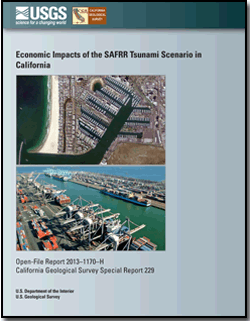 Introduction
Introduction
This study evaluates the hypothetical economic impacts of the SAFRR (Science Application for Risk Reduction) tsunami scenario to the California economy. The SAFRR scenario simulates a tsunami generated by a hypothetical magnitude 9.1 earthquake that occurs offshore of the Alaska Peninsula (Kirby and others, 2013). Economic impacts are measured by the estimated reduction in California’s gross domestic product (GDP), the standard economic measure of the total value of goods and services produced. Economic impacts are derived from the physical damages from the tsunami as described by Porter and others (2013). The principal physical damages that result in disruption of the California economy are (1) about $100 million in damages to the twin Ports of Los Angeles (POLA) and Long Beach (POLB), (2) about $700 million in damages to marinas, and (3) about $2.5 billion in damages to buildings and contents (properties) in the tsunami inundation zone on the California coast. The study of economic impacts does not include the impacts from damages to roads, bridges, railroads, and agricultural production or fires in fuel storage facilities because these damages will be minimal with respect to the California economy. The economic impacts of damage to other California ports are not included in this study because detailed evaluation of the physical damage to these ports was not available in time for this report.
The analysis of economic impacts is accomplished in several steps. First, estimates are made for the direct economic impacts that result in immediate business interruption losses in individual sectors of the economy due to physical damage to facilities or to disruption of the flow of production units (commodities necessary for production). Second, the total economic impacts (consisting of both direct and indirect effects) are measured by including the general equilibrium (essentially quantity and price multiplier effects) of lost production in other sectors by ripple effects upstream and downstream along the supply chain. An appropriate measure of the economic impacts on the California economy for the SAFRR tsunami scenario is the reduction in GDP.
The economic impacts are first calculated without resilience, the ability of the economy to adjust to disruptions in ways that mute potential negative impacts. There are many types of resilience, including using existing inventories of materials, using unused capacity, conserving inputs, substituting for disrupted supplies, recapturing production after the disruption is restored, and many others. A method for estimating resilience, identified in the port system and sectors affected by property damages, is applied to indicate potential reductions of direct and total economic impacts. In this SAFRR tsunami scenario analysis of economic impacts to California, we implement established techniques used to model the economic impacts for two previous U.S. Geological Survey (USGS) scenarios: the southern California Shakeout earthquake (Rose and others, 2011) and the California ARkStorm severe winter storm (Sue Wing and others, written commun., 2013).
For the SAFRR tsunami scenario, we reviewed the relevant studies that assess economic impacts from previous tsunami events affecting California and elsewhere and estimate the economic impacts of potential tsunami and other threats to POLA and POLB. To our knowledge, assessment of impacts to the California economy from distant source tsunamis does not exist. Previous tsunamis, including those from the 1960 Chile earthquake, the 1964 Alaska earthquake, the 2008 Chile earthquake and the 2011 Japan earthquake, had only relatively minor or very localized severe damage (such as that in Crescent City in 1964), and no studies of the economic impacts were completed. A rare study of the economic impacts of a tsunami event has recently been produced for the Tohoku earthquake and tsunami (Kajitani and others, 2013). Quarterly declines in Japan’s GDP are observed to peak at ‒1.63 percent in the second quarter after the event and stagnate for the rest of the year. The majority of the economic impacts are attributed to the tsunami rather than the earthquake. The hardest hit sectors are identified as agriculture, fisheries, manufacturing, retail, and tourism.
Other relevant studies have focused on the economic impacts of threats that close POLA and POLB. We find one analysis of a potential tsunami scenario affecting the California economy through disruption of port operations. Borrero and others (2005) estimated economic impacts to the southern California economy of $7 to $40 billion from a locally generated tsunami that closes POLA and POLB for as much as 1 year. There have also been several studies of the economic impacts of non-tsunami events affecting POLA and POLB. Analyses of an 11-day labor lockout produced a range of estimated national impacts of as much as $1.94 billion/day (Park and others 2008, Martin Associates 2001). Examination of a potential terrorist attack that closes the San Pedro port for 1 month yielded a $29 billion impact to the California economy (Park, 2008).
These studies have reinforced the importance of recognizing economic resilience in economic impact analyses. Hall (2004) criticized the upper-end estimate of national economic impacts from the labor lockout based on model shortcomings that neglected short-run substitution behavior and fixed the long-run economic behaviors. Following the 2011 Japanese tsunami, resilience was observed in the forms of rapid recovery of manufacturing sectors, energy conservation, and insurance (Kajitani and others, 2013).